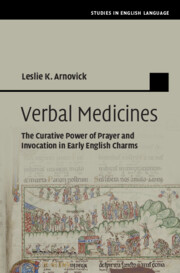Book contents
- Verbal Medicines
- Studies in English Language
- Verbal Medicines
- Copyright page
- Contents
- Figures
- Tables
- Introduction
- Chapter 1 Invoking Baptism
- Chapter 2 Psalm Charms as Aids against Illness
- Chapter 3 Invoking the Name of Mary
- Chapter 4 Invoking the Visitation of the Sick
- Chapter 5 The Multiplier Effect
- Chapter 6 Theoretical Implications
- Notes
- References
- Index
Chapter 5 - The Multiplier Effect
Published online by Cambridge University Press: 29 November 2024
- Verbal Medicines
- Studies in English Language
- Verbal Medicines
- Copyright page
- Contents
- Figures
- Tables
- Introduction
- Chapter 1 Invoking Baptism
- Chapter 2 Psalm Charms as Aids against Illness
- Chapter 3 Invoking the Name of Mary
- Chapter 4 Invoking the Visitation of the Sick
- Chapter 5 The Multiplier Effect
- Chapter 6 Theoretical Implications
- Notes
- References
- Index
Summary
Chapter 5, “The Multiplier Effect,” analyzes the ways in which verbal medicines are combined to effect healing or restore property. The various and multiple utterances individual charms like Lacnunga xxix perform can be ascribed to a programmatic approach to remedy. Combination therapy relies on an agglutinative process whereby separate utterances complement one another. The resulting amalgamation is more than the sum of its parts, however, and may be attributed to the multiplier effect. Charms combine verbal medicines in order to pursue every means of supplication available to God’s people: prayer to God, prayer for saints to intervene with God on the supplicant’s behalf, and liturgical prayer through the healing ministry of the Church.
Keywords
- Type
- Chapter
- Information
- Verbal MedicinesThe Curative Power of Prayer and Invocation in Early English Charms, pp. 197 - 218Publisher: Cambridge University PressPrint publication year: 2024

